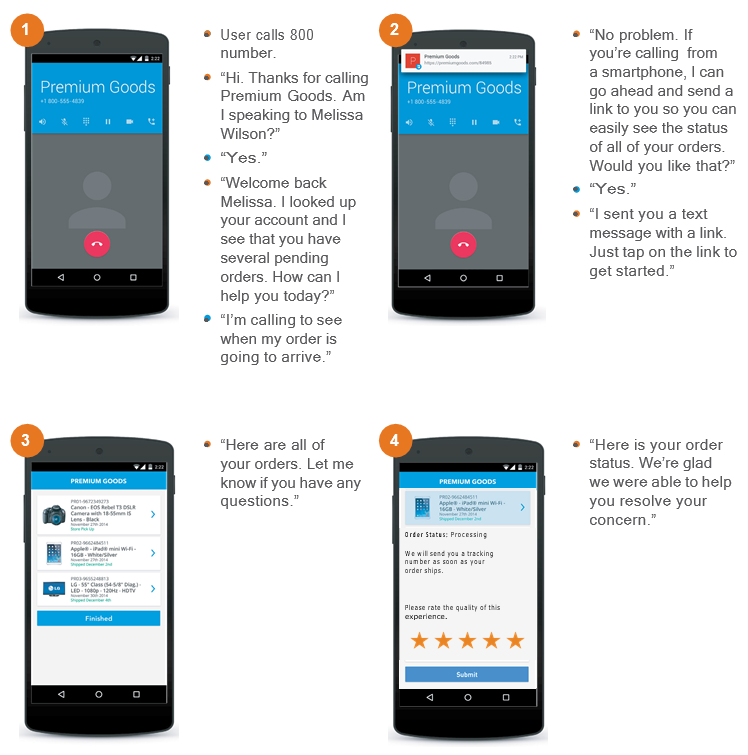Interactive voice response (IVR) is an automated phone system that enables callers to interact with a computer program, rather than a human voice agent. Virtually all IVR systems are able to route calls to the appropriate department or personnel (or a voicemail box) at the end of the process.
Traditional IVR systems prompt callers to supply simple information by selecting from a list of pre-set options and offer canned responses to the prompts the caller selects. These limited capabilities often lead to customer frustration, which is why conversational AI-powered IVR, offered on an omnichannel platform, is a game changer for customer experience (CX).
Read on to find out what an advanced IVR system is, how it works, and the benefits it delivers for your business.
When it comes to customer service and engagement, the voice channel reigns supreme.
Although organizations have focused much of their efforts and budgets on digital transformation in recent years, telephone calls still accounted for nearly three-quarters of inbound contact center interactions as recently as 2019. This includes self-service and agent-assisted calls, both of which are usually routed by an IVR .
IVR technology at its most basic level works by using dual-tone multifrequency signaling (DTMF) or voice recognition technology—sometimes both.
With DTMF, customers use their keypad to pick a menu option, no human operator necessary.
Voice recognition technology allows for directed dialogue, meaning a caller can give verbal answers instead of using a keypad. Callers are typically asked a question and given a limited number of possible responses. If they stray off script—that is, respond in ways that aren’t in the computer’s preprogrammed arsenal—they will be reach a dead end.
As Intuit cofounder Scott Cook once advised, “Instead of focusing on the competition, focus on the customer.” For most organizations with large customer service operations, this advice may not be revolutionary. However, it may surprise some to learn just how much customer experience can affect their bottom line. One in three customers say they would stop doing business with a brand they loved after just one bad experience—and 42% would pay more for a friendly, welcoming experience.1
One of the biggest culprits of poor service is an outdated IVR channel. By and large, consumers don’t like interacting with traditional IVRs. Just look at these stats on the subject:2
The cost effectiveness of an IVR compared to live agents is undeniable. However, companies can no longer afford to let poor customer experience (CX) from using IVR drive customers away. The question now becomes how to use an IVR to control support costs, while also providing an excellent customer experience.
Here are five important ways in which your current IVR is likely to disappoint your customers, along with strategies to transform your IVR into a customer service asset rather than a liability.
The issue: According to one survey, 52 % of Americans are frustrated at having to repeat themselves.3 This invariably drives customers away from your company or forces them to escalate to a more expensive channel where they’ll have to start over with a live agent. And that’s where the big problems begin.
You should make the context and details of your customers’ activity in the IVR channel available to other channels so you can provide a seamless, connected experience. By doing so, you’ll stop annoying virtually every customer who leaves the IVR in search of assisted service.
The issue: 50% of customers are on your website when they call your IVR.4 This is a strong indication that your customers want to self-serve, but also appreciate having a visual component to their customer service interaction. If what you provide instead is an outdated, confusing, audio only IVR, you’re introducing a level of customer frustration that’s hard to overcome.
The solution: Instead, look for a solution that pairs the visual experience with the voice experience, pushing rich, interactive content to an IVR caller’s smartphone or computer.
By doing so, you’ll be delivering a support experience that’s right in line with customer expectations. There are 3.5 billion smartphone users worldwide, so it’s no surprise that 69% of decision makers are citing self-service as a major part of their service strategy.5
A great way to make your IVR more mobile friendly is to offer callers the option to complete their journey online, by simply offering to send an SMS message that includes a link to a dynamic, interactive mobile web experience where they can complete their journey using the touch capabilities of their connected smartphone.
Here’s an example of how a visual and mobile-friendly IVR can look:

The issue: Recent research shows that 87% of customers start their journey in digital channels.6
The solution: To keep pace with today’s digital-first consumer, you need an IVR system that honors the fact that, by the time customers interact with your IVR, they are often far along in their customer service journeys.
Your IVR should be web-aware, meaning it should use the context from a customer’s web journey and detect if the customer is still on your website during the call. This enables greater personalization for callers in real time and makes channel-switching a nonissue along the journey, rather than a standout impediment.
The issue: Legacy IVR platforms leverage earlier-era voice recognition technology that only works well when customers say certain words in response to certain prompts. This causes customers to speak in very unnatural ways that slow the process down and creates frustration, and errors.
The solution: Today’s leading IVR platforms employ natural language technology processing (NLP) which interprets the natural everyday speaking language that customers use, and accurately derives the correct meaning from what customers are saying. This eliminates the frustration, making the call much easier for the customers and, ultimately, keeps more customers engaged with the IVR throughout the journey because abandonment due to speech recognition issues are a thing of the past.
The issue: With all these drawbacks, it should come as no surprise that in one study, 64 % of respondents described having negative feelings such as frustration when faced with an IVR.2
This customer frustration can arise at many points throughout the IVR interaction, such as during an overly complicated user authentication or while navigating confusing menu options. This can result in a “once bitten twice shy” syndrome, leaving your customers cringing at the idea of having to use your IVR again in the future, and a general lack of confidence in your IVR’s problem- solving abilities.7
The solution: By implementing natural language processing, making your IVR web-aware and providing digital engagement options as described above, you can avoid leaving your customers “snake bit” and provide them with a far more satisfactory IVR experience.
With statistics like these, finding an IVR that customers would describe as easy to use might sound like an impossible task. But new developments in technology have made intelligent, connected IVR systems not only possible, but easy to deploy. Look for systems that integrate visual and voice, allowing customers to easily authenticate their identities, visually bypassing the parts of the IVR that aren’t relevant to them and that can intelligently predict next steps—all things that instill confidence in your IVR channel.
IVR systems are a necessary cost-control measure for most large organizations that enable the handling of hundreds of thousands of customer service issues at scale. But times have changed, and “dumb” IVRs simply don’t meet the needs of today’s consumer very well. [24]7.ai is a leader in developing intelligent IVR solutions that provide multichannel customer service journey tracking, web-awareness, mobile optimization, and integrated voice and visuals for smooth, seamless customer journeys and faster self- service resolutions. Contact us today to learn more.
[24]7 Voices™: Delight customers with the natural interactions and increased self-service made possible by this AI-powered, IVR automated system.
Unlike traditional IVR phone systems, conversational AI-based IVR systems offer a superior customer service experience. Quickly and accurately identify customer intent through technologies such as natural language understanding (NLU), dramatically reducing or even eliminating hold times. Plus, a sophisticated IVR system increases a caller’s ability to self-serve, enabling you to handle rising call volumes without increasing agent headcount. And NLU supports unscripted interactions between the caller and the IVR, intelligently detecting customer intent and supporting natural conversations that feel human.
A better IVR experience boosts customer satisfaction and lowers costs. Happier customers and a healthier bottom line—that’s a powerful one-two punch. AI-powered conversations are natural, intuitive, and effective; customers speak the way they do normally and self-serve to get things done quickly and without friction. Advanced NLP, accurate intent prediction, and rich interactive capabilities increase self-service containment and elevate the customer experience (CX). Plus, when callers do need help from a live agent, the hand-off is seamless.
Companies invest in IVR systems primarily to reduce cost per transaction as well as to do a better job of meeting customer needs. That means empowering callers to resolve questions and complete tasks without ever speaking to an agent.
For this major bank, increasing call volumes had led to higher costs, longer handle times, and call routing challenges. By leveraging conversational IVR technology, the company made banking more automated, much faster, and more convenient for its customers.
Continually fine-tuning the system in close partnership with its voice solutions vendor enabled the bank to improve its IVR containment rate. Over the past 10 years, the bank’s conversational IVR solution has handled more than one billion self-service interactions with 99.996% uptime, saving it approximately $1 billion in net service costs.
An advanced IVR system transforms the voice channel and provides a multitude of benefits for customers, agents, and the business.
What it enables: Resolve customer issues faster by understanding accents, dialects, and slang expressions more accurately, even in noisy environments.
What it enables: Instantly implement voice prompt changes.
What it enables: With intent-based experiences, customers don’t try to skip the IVR—improving automation and self-serve containment.
What it enables: Deliver smoother IVR conversations, routing, and high-quality self-service by simplifying complex navigation. Respond appropriately to a sudden change of topic and ask clarifying questions to understand a caller’s intent.
What it enables: Combine voice and visual interactions to improve call containment rate.
What it enables: Reduce customer frustration with relevant context transfers.
What it enables: Deflect calls away from voice agents to lower-cost, faster-response channels.
What it enables: Improve operational efficiency when deploying and updating your IVR.
What it enables: Proactively reach customers to improve business outreach and service delivery.
What it enables: Discover actionable insights to measure and optimize IVR performance.
What it enables: Everything you need plus interoperability with all your enterprise systems.
What it enables: Expand your footprint across the globe and support a diverse customer base.
Taking the right steps to verify customers and safeguard sensitive customer data is more critical than ever. The majority of contact center fraud cases originate in the IVR, and this type of identity fraud instances jumped by 350% between 2013 and 2019, according to Transunion. Similarly, financial services organizations report identity theft as the top fraud type.
Fraudsters increasingly exploit inherent vulnerabilities in traditional authentication methods such as PINs, passwords, and knowledgebase (KB) security questions. To increase security, companies often ask customers for additional personal identification.
This is time-consuming for companies and frustrating for customers.
Because human voices, like fingerprints, contain characteristics unique to each individual, voice biometrics is able to identify speakers with a very high degree of accuracy, enabling brands to provide stronger authentication with less friction.
Voice biometrics can replace or augment traditional security methods, depending on the use case and risk level. High-risk transactions requiring multifactor authentication can combine voiceprints with sensitive customer information.
Companies that design secure customer journeys see not only an increase in customer trust and confidence, but also a boost to their bottom lines. According to Experian, 74% of customers consider security the most critical factor when deciding to engage with a business.
In a nutshell: Every time [24]7.ai clients reduce agent talk time, it saves them money and improves their CX. Voice biometrics ensures:
Most companies use human voice talent to record IVR prompts because customers dread listening to a robotic voice. Unfortunately, that’s a complicated, expensive, and time-consuming process, requiring a long lead time plus continual enhancement and management.
AI text-to-speech (AI TTS), often referred to as neural TTS, uses deep neural networks to overcome the limitations of traditional text-to-speech systems, matching the stress and intonation patterns in spoken language and synthesizing units of speech into a computer-generated voice. This results in a human-like, natural-sounding voice prompts.
Here are just a few benefits of using AI text to speech:
If your company is using an outdated IVR system, you’re giving your competitors an easy advantage. Instead, give your customers what they want—the ability to quickly resolve issues on their channel of choice without having to repeat themselves, navigate a frustrating menu, or wait for an agent. Boost customer satisfaction and self-service containment while controlling costs, elevating CX, and gaining new insights in your customer journeys and intents. That’s the power of modern, AI-powered IVR.

Interactive Voice Response (IVR) is an automated phone system that allows customers to first interact with a compute

Text-to-speech, also known as text-to-voice, can help enhance your business’s customer service offerings. Text-t